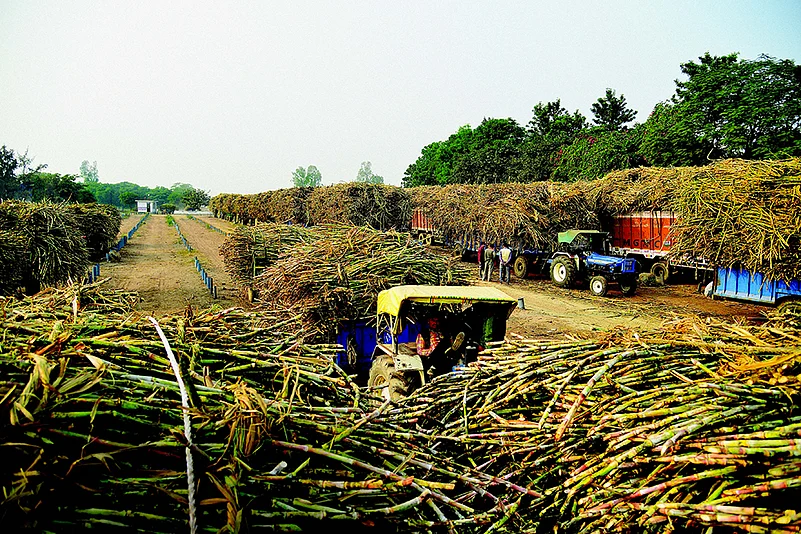On a mild chilly afternoon, Tarachand Sharma, a farmer in his late 60s, is sitting on a makeshift bed attached to the trailer of his tractor parked outside Simbhaoli Sugar Mill’s Brijnathpur unit. He has been waiting there for more than 36 hours, hoping that the mill would buy his sugarcane. He is not alone. Trucks and vehicles laden with sugarcane can be seen as far as the eye can see. “I haven’t received any receipt from the Society Commission for my sugarcane, but I came here to sell it because I don’t have the storage capacity to keep it,” says Tarachand.
While he waits with other farmers outside the mill for offloading their new produce, Tarachand complains that sugarcane growers still haven’t received payment for the previous sugar season. Anuj Tatsingh, who grows sugarcane on his 16-acre land, says it’s not only Simbhaoli Sugars, but several other mills located in various parts of western Uttar Pradesh (UP) haven’t paid farmers their due. “I have eight brothers who grow sugarcane in various parts of the state. All of them including me are waiting for payment,” complains Tatsingh. He adds that he isn’t hopeful of getting his dues anytime soon.

His pessimism isn’t unfounded. Several mills like Simbhaoli are in the red due to low sugar prices. With sugarcane production hitting a record high of 32 million tonne (MT) in sugar season (SS) 2017-18 (October-September), the sugar price hit a 28-month low of Rs.25.50 in April last year. As the cost of production at Rs.36/kg outstripped the selling price, sugar mills have been trapped in a cycle of debt and surplus.
Low Hope
The sugar sector is facing a crisis from abundance, and any relief isn’t in sight at least in the near term. After producing 32 MT in SS 2017-18, the industry is expected to add another 31.5 MT to the existing stock in SS 2018-19. Adding to the sector’s burgeoning woes, domestic demand still stands at 26 MT, which is still below expected production.
“The season has started on a negative note. We can clearly see that production will outstrip consumption. Downgrade in production numbers is a positive but still it will be higher than consumption number which means we will be adding to the stock,” says Tarun Sawhney, vice chairman and managing director, Triveni Engineering and Industries.
Triveni, which has seven sugar mills, six cogeneration units and one distillery spread over eight locations in UP, is reeling under the burden of rising arrears and plunging profit like other sugar mills in the region. The company’s payables increased by 145% in FY18, and lower sugar prices have dented profit.
Triveni’s net profit growth has been negative over the past four quarters with profit witnessing a steep drop of 71.65% in the September quarter. Along with Triveni, other big sugar producers such as Dhampur Sugar and Balrampur Chini are also staring at huge arrears as their profitability shrinks.
The arrears, including unpaid dues from the previous sugar season, are estimated at Rs.65 billion in the two major sugarcane producing states of UP and Maharashtra with the former alone accounting for Rs.40 billion.
Political Crop
The genesis of the problem — rise in arrears and overproduction — lies in successive governments’ policy to encourage farmers to grow sugarcane. Successive UP governments have increased the state advised price (SAP) each year in a bid to woo farmers, which constitute a large vote bank. The health of the industry is directly tied to the political fortunes of the ruling party as the sector impacts four million farmers in the state. The industry generates revenue worth almost Rs.500 billion through sugar, jaggery, ethanol, bagasse and cogeneration and is seen as the backbone of UP.
Hence, SAP, the price at which sugar mills have to procure sugarcane from farmers, has increased from Rs.280/quintal in SS 2015-16 to Rs.315/quintal in the current season. Rising SAP has had an adverse impact on the health of the mills as the cost of production has been increasing, and at the same time, the price of finished product is capped to appease consumers.
Despite the UP government’s decision to keep rates unchanged in an election year, private mill owners are asserting that the procurement price is still too high. “You cannot continuously pay more for the raw material than the final product. The regulated sugar price is not covering the cane cost. This has to be corrected,” opines Gursimran Mann, managing director, Simbhaoli Sugars.
The concern over non-linkage of cane prices and sugar prices is echoed by almost every sugar mill owner in the state. “For us, the production cost is roughly Rs.35/kg, and currently we are selling at a little over Rs.30/kg,” says Ajit Shriram, joint managing director, DCM Shriram. He adds that sugar export-driven countries such as Brazil, South Africa, Thailand and Australia have a policy in place to link cane prices to sugar prices.
Bailing Out
Even as the desperate plea of the sugar industry to address the structural flaw falls on deaf ears, the Centre and UP governments are doling out bailout packages to provide temporary relief. The defeat in the Kairana Lok Sabha by-polls has jolted the government into action. On June 5, the central government announced a bailout package of Rs.70 billion including soft loans to the tune of Rs.44 billion and interest subvention for augmenting ethanol capacity in India. The UP government also swung into action. With the sugar mills in the state being burdened by arrears, the government allocated around Rs.65 billion in the state supplementary budget for early settlement of dues.
The Indian government is also looking to increase exports, asking sugar mills to mandatorily export five million tonnes in SS 2018-19. However, exports might not be a viable option as even the global sugar market is facing a glut. White sugar was trading at Rs.25/kg on the London Commodities Exchange in the early weeks of 2019, which is still lower than the production cost.
So sugar mills will be exporting at a loss, but Sawhney believes it’s the only way forward for the industry to reduce the surplus. “You have to bear the loss, but it’s in the interest of the industry. Also, any price improvement in the coming months might make it viable,” feels Sawhney.
While the government looks to ease sugar industry’s woes through a mix of bailout packages and export thrust, the decision to hike ethanol price is expected to protect cash flow and improve margins. On September 12, the government decided to hike the price of ethanol, produced directly from sugarcane juice for blending in petrol, by 25% from Rs.47.13 to Rs.59.13/litre.
The industry has welcomed the move and is expecting a fresh inflow of investment for building distilleries. “The growth in the industry is coming out of distillery segment, which is witnessing capital deployment for setting up huge capacities,” says Sawhney. He adds that the government’s decision to provide subsidies for distilleries should also help in absorbing the financial burden of setting up a new factory.
Even as sugar mills embark on an expansion spree, they are urging the government to fix ethanol policy on a long term basis. “If more sugar has to be diverted for the production of ethanol, then there has to be long-term pricing. Currently the ethanol price hike is only for a year. The government must declare pricing for at least ten years; only then sugar mills will invest to double their capacity,” says Mann.
Also, given the delay in obtaining clearances, a long-term policy can create certainty and give mills the confidence to invest. “To get the required clearances, it takes 12 months and then another 24 months to set up a distillery, so a long-term policy on the ethanol front is essential,” opines Sawhney.
Local Woes
Apart from bailout packages and fixing structural flaws, the sugar sector in UP also needs less state interference. “One needs to get multiple clearances to set up an ethanol manufacturing unit. You need clearance from Ministry of Environment and Forests (MOEF) for groundwater clearances and a host of other clearances. Right now, the process is long and tiresome,” says Sawhney.
From elimination of ‘unnecessary’ taxes to expediting the process of setting up factories, sugar mills are urging the local and central governments to usher in change. “Certain charges like society commissions tax can be done away with. The factories can subsume all the activities they are doing at a much lower cost. And it can help to build more efficiency into the system,” claims Sawhney.
The government’s decision to allocate around Rs.10 billion to co-operatives to meet payment commitments to farmers for the 2017-18 and 2016-17 SS, has also raised eyebrows. Highlighting the subsidies given to co-operatives in the state, Mann questions the preferential treatment given to state-run sugar mills.
“Varying degree of support is given to mills. Why is the government paying farmers linked to co-operatives but not those linked to private mills? This issue also needs to be addressed. Differential support is a big concern. You are paying less efficient producers using tax-payers money,” says Mann. She adds that the sales and production numbers of co-operatives are deficient compared to privately run mills and hence the subsidies cannot be justified.
Grim Future
Despite a spate of bailouts and ethanol price hike, the core issue of surplus can only be solved through major structural reforms. Sugar mills owners believe that only through linkage of cane prices and sugar prices, the woes of the industry will ease. Shriram says, “Giving loans and bailouts is not the way to keep industry healthy. Linking sugarcane prices to sugar prices is an important structural change which must be implemented,”
Sawhney agrees with Shriram. “This structural flaw sets off a vicious cycle leaving the industry a loser always. Even farmers lose since their fortunes fluctuate wildly. Farmers’ income is tied to the health of the industry. They will get their dues only if the industry is generating positive cash flow,” adds Sawhney.
To fix the issue of these fickle fortunes, Sawhney recommends the setting up of a stabilisation fund. “It can be auto-funded by the sugar sector. If prices rise, there can be a levy, and that gets collected in this pool. If prices drop, this reserve can be utilised,” explains Sawhney.
From sugar mill owners to farmers to transporters — everyone is bearing the brunt of political fixation over sugarcane prices. The solution to the sugar surplus is simple: the government must stop fixing sugarcane prices. Not only sugar mill owners but farmers too are realising the perils of government intervention.

















